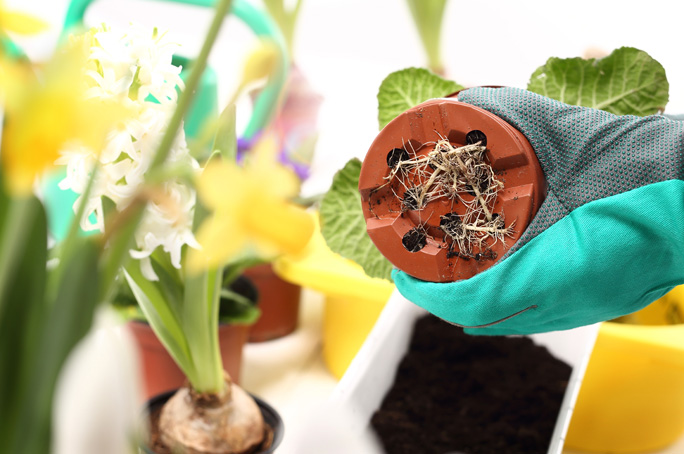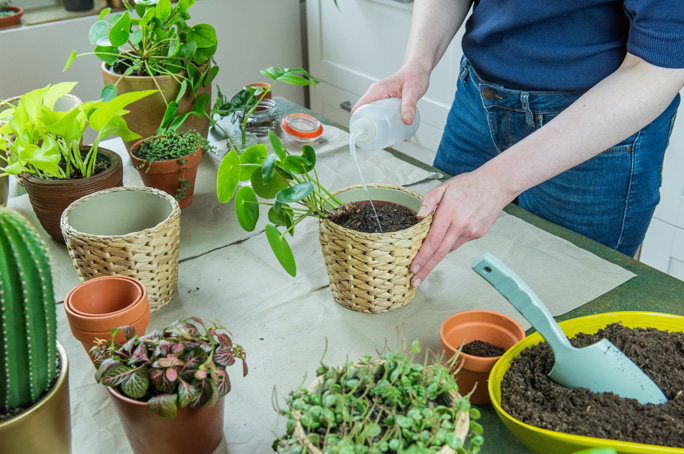Repotting is fun, they say, but is it really? Of course! Even a laboring task like moving your plants from one pot to another can be fun if you know how to do it right. That’s why we’ve compiled a list of common repotting mistakes, ways to tackle them, and plants that don’t need frequent repotting. Let’s go!
When to Repot?

This depends on the type of plant you have. Some plants don’t need to be repotted at all (ones that grow in the open ground), while others need to go through this once a year. Usually, you can tell if a plant needs moving just by looking at it; the telltale signs are wilted, drooping leaves caused by a lack of water, stunted growth, and roots coming through the drainage holes. Remember that plants should be repotted in spring when they come back from their winter sleep and get ready for active growth.
What About Transplant Shock?

Repotting is a big stress for plants no matter your gardening skills. Wouldn’t you be anxious after moving to a new house? To ease your plant’s way into its new home, you need to provide it with the best possible care. Make sure you don’t disturb the root ball during repotting (don’t knock off all the old soil, leave some of it on the roots). Thoroughly water your plant after the process (note: succulents and cacti need a cooling-off period, so you need to wait for about a week after repotting before watering them). Of course, a big denominator in transplant shock recovery is whether you’ve avoided some crucial repotting mistakes, such as:
- Using the old soil. It’s not a good idea to go with the soil your plant has already used. You can’t eat an empty box of cereal, right? Fresh soil will have enough nutrients to sustain your plant for another year and even more!
- Moving the plant outside. Your plant will have a hard time acclimating to the new pot; no need to make it even harder by changing the environment! You can move it outside, for example, when it gets used to the new place and starts growing.
- Repotting in winter. Most plants go into dormancy in winter, so disturbing their sleep is a big no-no. Winter days are the shortest, so plants have a much harder time adapting to new conditions and become leggy, as shoots stretch toward the nearest light source.
- Repotting seedlings. If they have just started establishing, let them be for a moment. Wait until they’re well-developed and move them in spring or summer.
How Do I Deal With Repotting Stress?

- Give your plant a trim if it has damaged or diseased shoots.
- Thoroughly water it. Keep the soil moist at all times but not to the point of sogginess.
- Don’t fertilize yet. While it may seem counterintuitive, fertilizing isn’t going to help your plant acclimate faster. In fact, stay away from it for about 2 to 3 weeks after repotting to avoid accidentally overfertilizing the plant.
- Use a growth stimulant. This will boost your plant’s immunity and help it get used to the new pot faster.
- Revise the care conditions necessary for your plant. If the humidity is too low or the sunlight is too high, you need to make some adjustments. Plantum’s plant care guides will help you with that.
If you’re in the league of people who want to do as little repotting as possible, here are a few plants that don’t need to be moved that often:

- Aloe
- Hoya
- Sago palm (Cycas revoluta)
- Chinese money plant (Pilea peperomioides)
- Cast-iron-plant (Aspidistra elatior)
- Mother-in-law’s tongue (Sansevieria)
- Christmas cactus (Schlumbergera)
- Banyan (Ficus benghalensis)
- Sword fern (Nephrolepis exaltata)
We hope this article was useful to you, and your next repotting will go smoother than ever!
